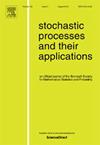Multiple and weak Markov properties in Hilbert spaces with applications to fractional stochastic evolution equations
IF 1.2
2区 数学
Q3 STATISTICS & PROBABILITY
引用次数: 0
Abstract
We define a number of higher-order Markov properties for stochastic processes , indexed by an interval and taking values in a real and separable Hilbert space . We furthermore investigate the relations between them. In particular, for solutions to the stochastic evolution equation , where is a linear operator acting on functions mapping from to and is the formal derivative of a -valued cylindrical Wiener process, we prove necessary and sufficient conditions for the weakest Markov property via locality of the precision operator .
As an application, we consider the space–time fractional parabolic operator of order , where is a linear operator generating a -semigroup on . We prove that the resulting solution process satisfies an th order Markov property if and show that a necessary condition for the weakest Markov property is generally not satisfied if . The relevance of this class of processes is twofold: Firstly, it can be seen as a spatiotemporal generalization of Whittle–Matérn Gaussian random fields if for a spatial domain . Secondly, we show that a -valued analog to the fractional Brownian motion with Hurst parameter can be obtained as the limiting case of for .
希尔伯特空间中的多重和弱马尔可夫性质及其在分数阶随机演化方程中的应用
我们定义了随机过程(X(t))t∈t的若干高阶马尔可夫性质,该过程以区间t≥R为指标,取实可分Hilbert空间u中的值。特别地,对于随机演化方程LX=Ẇ的解,其中L是作用于从T映射到U的函数的线性算子,(Ẇ(T)) T∈T是U值圆柱Wiener过程的形式导数,我们通过精度算子L * L的局域性证明了最弱马尔可夫性质的充分必要条件。作为应用,我们考虑了阶γ∈(1/2,∞)的时空分数阶抛物算子L=(∂t+A)γ,其中−A是一个在u上生成c0半群的线性算子,证明了当γ=N∈N时解过程满足N阶马尔可夫性质,并证明了当γ∈N时一般不满足最弱马尔可夫性质的必要条件。这类过程的相关性是双重的:首先,对于空间域D哉Rd,如果U=L2(D),则可将其视为whittle - matn高斯随机场的时空推广。其次,我们证明了对于H∈(0,1)的分数阶布朗运动的u值模拟可以作为L=(∂t+ i i u)H+12对于i↓0的极限情况。
本文章由计算机程序翻译,如有差异,请以英文原文为准。
求助全文
约1分钟内获得全文
求助全文
来源期刊

Stochastic Processes and their Applications
数学-统计学与概率论
CiteScore
2.90
自引率
7.10%
发文量
180
审稿时长
23.6 weeks
期刊介绍:
Stochastic Processes and their Applications publishes papers on the theory and applications of stochastic processes. It is concerned with concepts and techniques, and is oriented towards a broad spectrum of mathematical, scientific and engineering interests.
Characterization, structural properties, inference and control of stochastic processes are covered. The journal is exacting and scholarly in its standards. Every effort is made to promote innovation, vitality, and communication between disciplines. All papers are refereed.
 求助内容:
求助内容: 应助结果提醒方式:
应助结果提醒方式:


